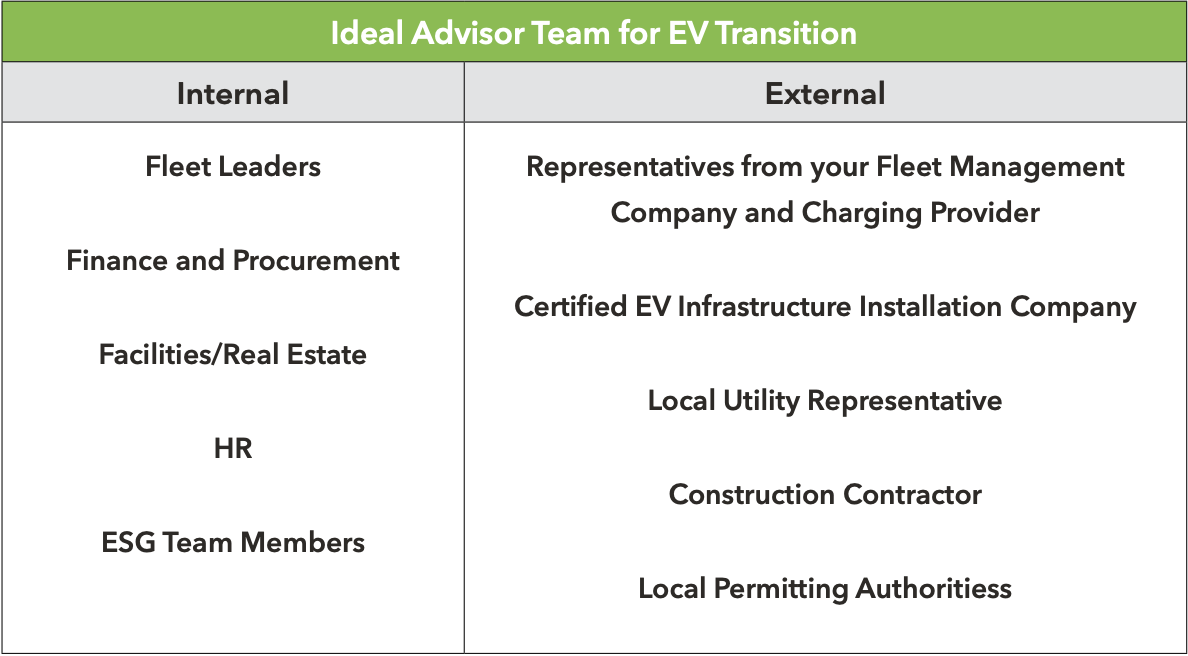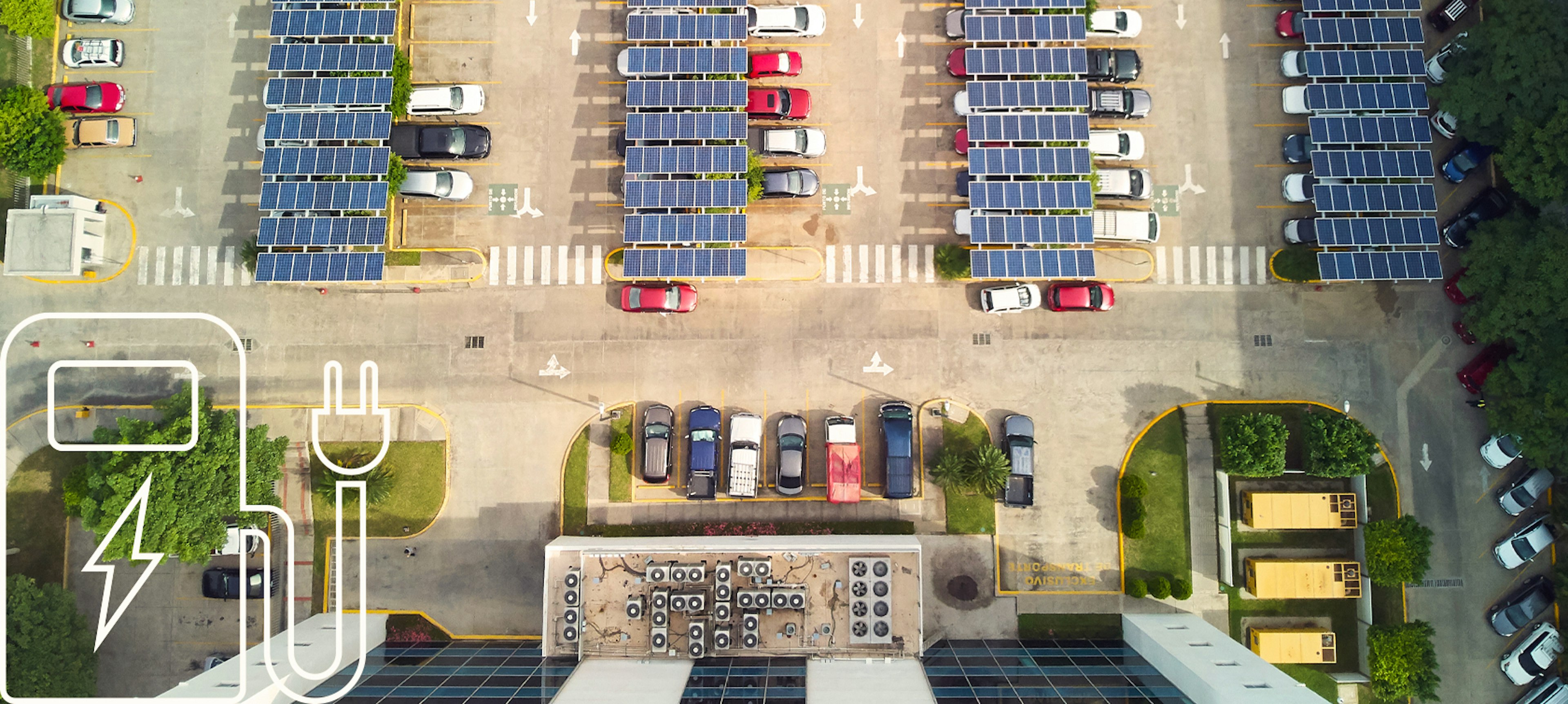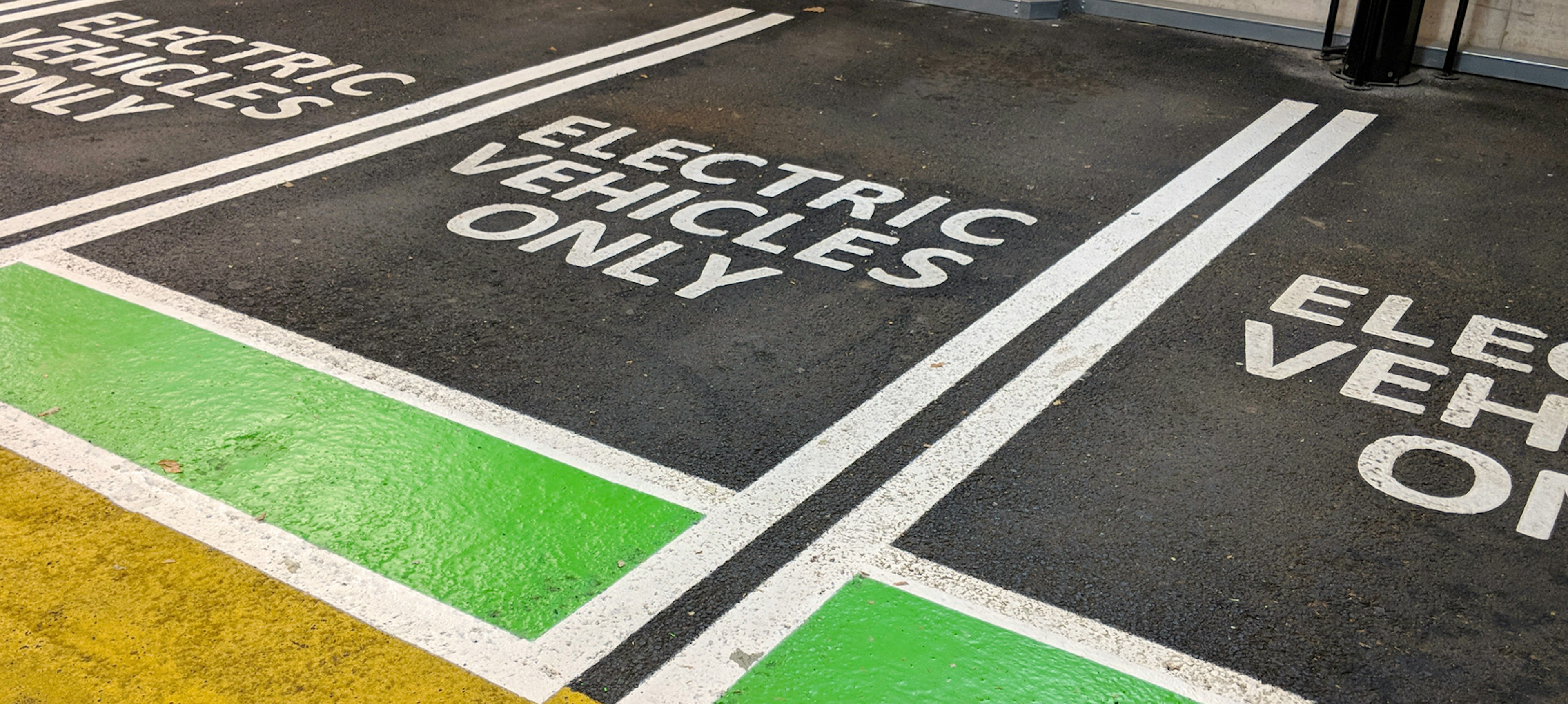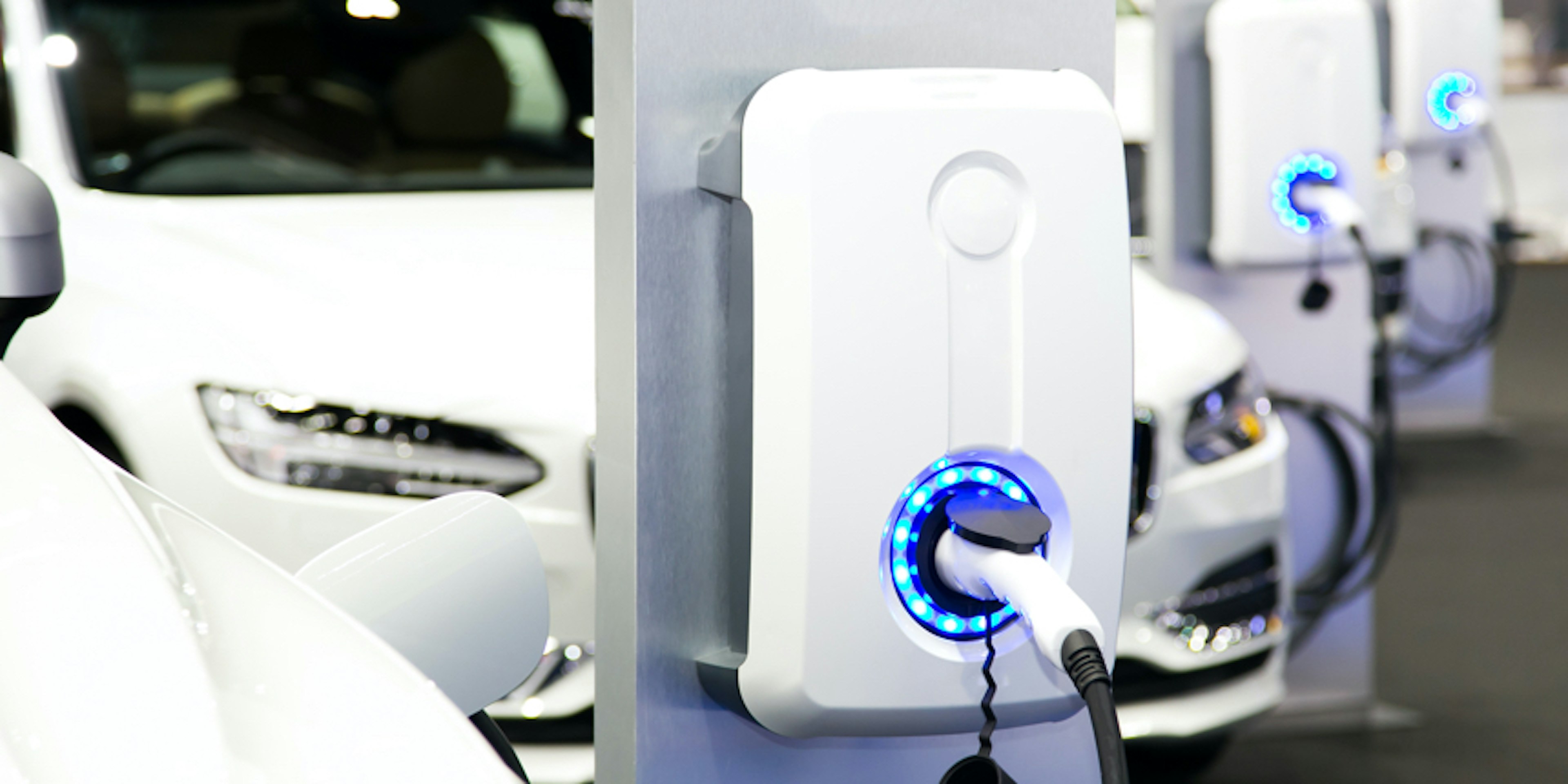So, you’re thinking about adding EVs to your fleet. It’s a big decision with potentially big rewards, notably significant cost savings. But there’s plenty to ponder first. Before you travel down the electric powertrain path, here are ten considerations to keep in mind to ensure the smoothest transition possible.
- What do you hope to accomplish by adding EVs to your fleet?
- Who are the stakeholders you need to involve in your transition effort?
- Are EVs appropriate for your fleet?
- Is there an EV that meets your requirements?
- How much will EVs save you?
- What’s your charging plan?
- Do you have an appropriate charging site?
- Are your drivers and technicians ready?
- How will you measure and report success?
- What’s next?
Let’s look at each one in detail.
What do you hope to accomplish by adding EVs to your fleet?
The best place to begin? It’s with this question: What’s your motivation for wanting to add EVs to your fleet? Among the most common reasons are to:
- Lower your total cost of ownership (TCO) by reducing the cost of maintenance and energy.
- Fulfill drivers’ requests for quieter, cleaner-running vehicles.
- Gain an edge over competitors who don’t rely on EVs.
- Comply with applicable federal and state regulations.
- Contribute to your company’s ESG and sustainability goals.
- Impress customers and employees with your environmental commitment.
Knowing your motivations will help you make critical decisions along the way and give you a clear sense of how best to proceed throughout the transition process. For example, if regulations drive your decision, you’ll know precisely how many EVs you need in your fleet to meet those regs. If the motivation is different, the best number of vehicles to initially electrify is more nuanced.
Your motivations should also provide a means of measuring success. If you aim to lower maintenance costs, you can look at historical and current records to gauge how much you’re saving. If less pollution is the measure, you can calculate how much carbon dioxide (CO2) your EVs aren’t emitting into the atmosphere. Also, realize that you can measure CO2 reduction via a hybrid or plug-in hybrid or even a more efficient gas or diesel internal combustion engine (ICE) vehicle versus the current model used in your operations.
Clarity about your motivations will also help you communicate with employees, drivers, and customers about why you’re adding EVs to your fleet and how you expect your company to benefit. As with any significant change, transitioning to EVs will likely raise questions and perhaps generate pushback. Clear and consistent communication about your decision will go a long way toward overcoming any uncertainty and hesitation.
"You need to look at the nuts and bolts of your business and ask if EVs make sense. Maybe you only use them initially for, say, staff cars or highly congested areas."
Christina Hartzler, Client Partnership Manager National, Mike Albert Fleet Solutions
Who are the stakeholders you need to involve in your transition effort?
Given the significant change EVs represent to a fleet, the fleet manager should gather a multidisciplinary team to first determine the feasibility of adding EVs and, if that is approved, develop and execute a plan.

Are EVs appropriate for your fleet?
Just because you can transition to EVs doesn’t mean you should. Data, the heart of every fleet, will steer you toward the best course of action. If, instead, you rely on hunches or best guesses about such factors as how many miles are logged daily by each vehicle, you could come to regret your decisions.
Here are some fundamental factors to help you determine if there’s a place for EVs in your fleet:
- Daily mileage logged (average and peak). This is critical since batteries have a maximum range. (You can compare some EV ranges at FuelEconomy.gov)
- City vs. highway miles. The faster the average speed, the quicker the battery will drain.
- Operating conditions. Particularly hot and cold environments will hurt battery range (as well as battery charging). In addition, hilly or mountainous terrain will also discharge the battery faster.
- Auxiliary power. Using additional power to operate lifts, cranes, and the like will reduce your battery’s performance.
- Average payload weight. The heavier the vehicle’s payload, the more power the battery requires.
- Towing. Pulling loads will also drain the battery faster.
"Data and electric vehicles go together like peanut butter and jelly. You’ll definitely have a much better experience electrifying part of your fleet with the relevant data."
Jason Kraus, Director, Vice President, Operations, Mike Albert Fleet Solutions
Is there an EV that meets your requirements?
For many fleets, the odds are good that at least some of your vehicles could tran- sition easily to EVs. After all, there’s an EV for virtually every vehicle class and type, including EV cargo vans. That said, there may not be a make and model that fits your needs well, especially considering the factors in Section 3 on the previous page.
To explore medium and heavy-duty EV options, check out Global Drive to Zero. For sedans, SUVs, and light-duty trucks, you’ll find Car & Driver a helpful resource. Alternatively, talk to a trusted fleet management partner like Mike Albert Fleet Solutions.
Generally, it’s best to phase in EVs rather than do a dramatic, top-to-bottom swap. This enables fleets to test the EV waters and determine what works best regarding charging, driver training, and more.
You have options.
Remember that all-electric vehicles (aka, battery electric vehicles, or BEVs) are not your only option. Plug-in Hybrid EVs (PHEVs) could make more sense for your fleet because they can run on conventional fuel to gain extended range. Another benefit is that PHEVs can be charged with a standard electric outlet and have a full battery range by morning without the expense of adding a Level-2 charger.
How much will EVs save you?
To appreciate the TCO of EVs, one must consider their savings. For starters, electricity is less costly than traditional fuel and less volatile in pricing. In addition, EVs are less costly to maintain. This is partly because they have far fewer moving parts, use fewer fluids, and experience reduced brake wear thanks to regenerative braking. However, the maintenance news is not all good. Due to the battery’s weight, EVs are harder on the tires, necessitating more frequent changes over the vehicle’s life.
Regarding TCO, one should also factor in any available tax credits or incentives. In addition to what the federal government currently offers, a state-by-state breakdown from US News & World Report is an excellent place to explore what credits may be available.
On the other side of the tax credit coin: Since EVs don’t contribute to gasoline taxes, some states aim to make up for that lost revenue through additional registration or title fees. You’ll want to factor this into your TCO calculations.

An ever-changing landscape.
In many ways, the world of electrified powertrains is still in its relative infancy. As such, the landscape continues to change with OEMs shifting their investments in EVs and battery production. In addition, keep in mind that political decisions drive these government tax breaks and can be revoked or otherwise changed. For instance, some pundits are predicting the federal tax credit will go away under President Trump’s administration. The moral of the story is to stay on top of EV news or work with a fleet management company (FMC) that does.
How much does it cost to charge an EV?
While the cost of charging an electric vehicle is variable, here’s a sample com- parison using a Kia Sportage, a Compact SUV that gets 28 combined city and highway miles per gallon. Assuming the vehicle logs 1,000 miles per month, it would consume 35.71 gallons, which, at AAA’s national average of $3.02 a gallon, would total $107.84 per month.
Conservatively, most EVs can get 3 to 4 miles per kilowatt hour (kWh); using our 1,000-mile-per-month example, that equates to about 330 kWh. Using the average U.S. household charging rate of about 16 cents per kWh, you can expect to pay about $53 a month to charge your EV. That’s an annual savings of $648 per vehicle on fuel alone.
“EVs are not only fun to drive and better for the environment, but they also save fleets lots of money, which is going to fuel mass adoption."
Amy Blair, National Fleet Sales Director, ChargePoint
What’s your charging plan?
Beyond making the fundamental decision to transition to EVs, charging the vehicles is among the most intricate and essential factors.
The ideal scenario is when vehicles return to a depot or drivers’ homes every evening, where they can charge overnight. This allows you to avoid relying on public chargers, which will drive up your costs.
Consider two things when charging needs to happen at the drivers’ homes. First, if the driver doesn’t own the house (or lives in an apartment), installing a charger may not be an option. Second, depending on the distance between the garage and the home’s electrical box, the installation cost will typically run between $1,500 and $5,000. It’s a bit more complicated for vehicles that don’t return to the same point every evening, such as those driven by salespeople. For one, the drivers may have to rely on pricier public charging. On the positive side, more public fast-chargers are quickly coming online. Plus, Tesla has been opening its chargers to other OEMs, providing additional charging supply.
For those who have to rely on public charging (aka “charging in the wild”), fuel management firm WEX offers a card that can be used at virtually every public charger. This makes charging convenient for drivers while providing access to insightful charging data. Lastly, realize that many hotels have been adding Level-2 chargers to support their customers.
Meet “Charging as a Service”.
Just as some tech companies will provide software and the needed infrastructure for a set fee (Software as a Service, or SaaS), some companies offer a no-capital-expense solution to charging infrastructure. These Charging as a Service (CaaS) companies will develop your infrastructure and oversee the electrical delivery for a monthly fee.

Do you have an appropriate charging site prepared?
You’ll want to partner early with your local utility company, which can help you plan for adequate power, including the ability to cover your maximum power demand or load profile. Your site’s proximity to the current electrical infrastructure will significantly impact the development cost. (Be sure to ask your utility if they offer discounts for charging EVs—this may require setting up a separate meter to monitor the electricity used specifically for charging.)
You’ll also want to explore any permitting issues that could complicate the development of your charging infrastructure. The number and type of chargers will depend on several factors, including vehicle types, how long they’re idle at the depot, and how much range they need. Depending on your situation, multiple vehicles may be able to share a charger.
Other factors to consider in your site evaluation include:
- Does your site have the necessary security?
- Have you factored in protection from a range of poor weather conditions?
- If you rely on a networked charging solution, you’ll need wireless service in the charging area.
- Can the site accommodate additional EVs in the future?
- Have you planned for site upkeep and maintenance?
Are your drivers and technicians ready?
EVs drive a bit differently than ICE vehicles. For instance, they accelerate much faster, and the regenerative braking has a slightly different feel. That’s why it’s best to arrange a time for your drivers to test an EV and get comfortable with it. Note that some medium and heavy-duty vehicle OEMs offer driving training programs.
In addition, it helps to educate new drivers on what does— and doesn’t—drain the battery. For example, faster speeds and cabin heating and cooling will meaningfully impact range. Car and Driver offers tips for maximizing range that you can share with your drivers.
There’s nothing particularly complicated about driving or charging an EV. Still, a brief introduction can go a long way toward establishing that initial comfort and ensuring safe operations from the get-go. Plus, such training can help ease any range anxiety your drivers may have
You’ll also want to ensure that the technicians at your main- tenance and repair shops are certified to care for your EVs or find new certified partners. This will prevent you from being the EV “guinea pig” for technicians who are getting up to speed on EV maintenance.
Not all charging companies are the same.
A true charging standout is ChargePoint. In 2024, they achieved a million ports and logged an impressive 99% uptime. They operate a facility in Campbell, California, where they perform interoperability tests to ensure that the charge provided by a specific charger type will work with the intended vehicles. This goes a long way toward driver happiness with EVs.
Learn more at ChargePoint.com.
How will you measure and report success?
You transitioned to EVs for a reason. (See #1 pg. 3) So, set some relevant bench- marks, gather the necessary data, and report on your progress and success to internal and, perhaps, external audiences.
For example, if reducing your costs is the driving goal, you can report the amounts saved on fuel and maintenance to your leadership team. If building your brand and connecting with customers is a key motivation behind your transition to EVs, you’ll want to boast about what you’re doing to improve the environment. The Harvard Business Review reports that a company’s environmental record can build trust, particularly with younger people.
Some ways to promote your carbon-reducing EVs to customers include:
- Emails
- Annual reports
- Vehicle wraps
- Signage at your HQ and other locations
What’s next?
The EV transition process is never truly complete. There’s always something else to consider or explore. For instance, based on EV performance to date, what other vehicles in your fleet may be ripe for a transition? What new charging technologies may be worth the investment?
As you ponder a transition, consider contacting Mike Albert Fleet Solutions to assist you with EV fleet management. We’ve helped many fleets evaluate how best to implement EVs. We can assist you with the initial evaluation through implemen- tation, including vehicle acquisition, and, with our partner ChargePoint, guide you to the best charging infrastructure options.
If you’re ready to consider EVs, we’re ready to assist you on this journey. Contact us on mikealbert.com.



